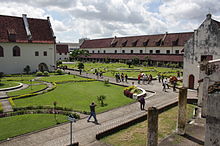Historical context
The service and hospitality sector that linked to travel and leisure probably already exist since ancient Indonesia, especially ancient Java circa 8th century. Some panels in Borobudur bas-reliefs depicted drink vendors, warungs (small restaurant), and there is a building depicting people drinking, dancing and having fun, seems to describe tavern or lodging. The historical record about travel in Indonesia can be found since 14th century.[25] The Nagarakretagama reported about King Hayam Wuruk's royal travel throughout Majapahit realm inEast Java with large numbers of carriages, accompanied by nobles, royal courtiers, officials and servants.[25] Although it seems as stately affair, for some instances the king's journey is somewhat resembles modern day tour, as the king visited numbers of interesting places; from temples such as Palah and Jajawa, to enjoying mountain scenery, having bath in petirtaan (bathing pools) and beach. The 15th-century travelogue of Bujangga Manik, a travelling Hindu scholar-priest from Pakuan Pajajaran, reported about his travel around Java and Bali. Although his travel was a pilgrimage one; visiting temples and sacred places in Java and Bali, sometimes he behaves like a modern day tourist, such as sitting around fanning his body while enjoying beautiful mountain scenery in Puncak area, look upon Gede volcano that he describes as the highest point around Pakuan Pajajaran (capital of Sunda kingdom).[26]
Initially the tourism, service and hospitality sector in Dutch East Indies were developed to cater the lodging, entertainment and leisure needs of domestic visitors, especially the wealthy Dutch plantation owners and merchants during their stay in the city. In the 19th century, colonial heritage hotels equipped with dance halls, live music and fine dining restaurants were established in Dutch East Indies urban areas, such as Hotel des Indes (est. 1829) in Batavia (now Jakarta), Savoy Homann Hotel (est. 1871) in Bandung, Hotel Oranje (est. 1910) in Surabaya, and Hotel De Boer in Medan. Since the 19th century Dutch East Indies has attracted visitors from The Netherlands.[25]The first national tourism bureau was the Vereeeging Toeristen Verkeer, established by Governor General of Dutch East Indies in early 20th century, and shared their head office in Batavia with Koninklijke Nederlansch Indische Luchtfahrt Maatschapijj (part of KLM) that began to fly from Amsterdam to Batavia in 1929.[25] In 1913, Vereeneging Touristen Verkeer wrote a guide book about tourism places in the Indies. Since then Bali become known to international tourist with foreign tourist arrivals rose for more than 100% in 1927.[25] Much of the international tourism of the 1920s and 1930s was by international visitors on oceanic cruises. The 1930s did see a modest but significant influx of mainly European tourists and longer term stayers to Bali. Many came for the blossoming arts scene in the Ubud area, which was as much a two-way exchange between the Balinese and outsiders as it was an internal phenomenon.[27]
Tourism more or less disappeared during World War II, Indonesian National Revolution and in the early years of the Sukarno era. On 1 July 1947, the government of Republic of Indonesia tried to revive tourism sector in Indonesia by establishing HONET (Hotel National & Tourism) led by R. Tjitpo Ruslan. This new national tourism authority took over much of colonial heritage hotels in Java and all named as "Hotel Merdeka". After Dutch–Indonesian Round Table Conference in 1949, this tourism authority change its name to NV HORNET.[25] In 1952 the President formed the Inter-Departement Committee on Tourism Affairs that responsible to explore the possibility to reestablish Indonesia as world's tourism destination.[28] National pride and identity in the late 1950s and early 1960s was incorporated into the monumentalism of Sukarno in Jakarta— and this included the development of grand multi-storied international standard hotels and beach resorts, such as Hotel Indonesia in Jakarta (est. 1962), Ambarrukmo Hotel in Yogyakarta (est. 1965), Samudra Beach Hotel in Pelabuhan Ratu beach West Java (est. 1966), and Inna Grand Bali Beach Hotel in Bali (est. 1966). The political and economic instability of the mid-1960s saw tourism decline radically again. Bali, and in particular the small village of Kuta, was however, in the 1960s, an important stopover on the overland hippy trail betweenAustralia and Europe, and a "secret" untouched surf spot.[29] In the early-to-mid-1970s, high standard hotels and tourist facilities began to appear in Jakarta and Bali. After the completion of Borobudur restoration project in 1982, Yogyakarta become a popular tourist attraction in Indonesia after Bali, mostly attracted to this 8th-century Buddhist monument, surrounding ancient Javanese temples and Yogyakarta Sultanate palace. From this period to the end of the Suharto era, governmental policies of the tourism industry included an array of regulations and developments to encourage increasing numbers of international tourists to both visit Indonesia and stay longer.
source wikipedia



No comments:
Post a Comment